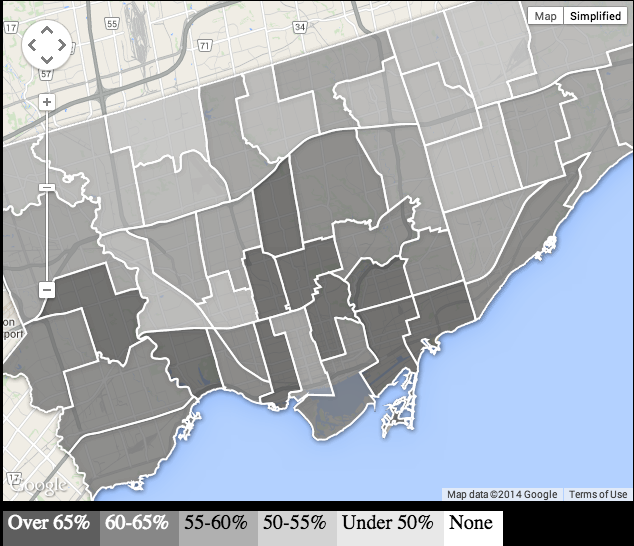In what was surely the most-anticipated municipal mayoral race of my lifetime, October 27th marked the finish line: election day. With Rob Ford registering his intent to run again on January 2nd, the 10-month race was on. Ford’s two foes in this race, John Tory and Olivia Chow, were the only others in that mattered–although dozens of other candidates ran for mayor. The debates were focused on these three from the get-go–and when the Ford brothers’ shocking last-minute switch occurred on September 12th, Doug Ford merely stepped into his brother’s place as Rob ran instead for the Etobicoke North riding he had represented for a decade (2000-2010). Would Ford Nation embrace Doug as they had embraced Rob?
Tonight’s results were a resounding “No!” With a record-breaking 60% voter turnout, Toronto has chosen John Tory as mayor.

How did Tory win? Or rather, how did the Fords lose? The public had gotten sick of the drama that was city hall, ironically from a mayor who was elected to reduce government waste and inefficiency. For many, the last-minute substitution of one Ford for another was simply too much to take. Suspicious voters turned out in droves to force the Fords out–but only in the mayoral race. Rob has been re-elected as city councillor in Ward 2 Etobicoke–cancer treatment and all. Olivia Chow entered the race strong, but many analysts and journalists say that she began to lose traction in the summer–for reasons nobody has been able to figure out. Tonight on CBC, journalists said she ran “too sensible” of a campaign, “always took the high road”, and noted that the twin spectres of racism and sexism had reared their ugly heads during the past few months; ironically a female journalist covering the results criticized Chow as “too nice”, a descriptor that would likely not be applied to a male candidate. Indeed, in the male-dominated arena of debates (or shouting matches), it was difficult for an intelligent and sensible woman to win over two candidates who alternately proposed pipe dreams and vague ideas with equal amounts of bluster–difficult, as well, to withstand members of the public who taunted her ethnocultural background or gender. By summer, the race had become about one issue: transit. Tory introduced his SmartTrack idea which, although vague and lacking a realistic funding strategy, gained remarkable traction with the public over Chow’s simpler, cheaper plan–by the time Doug Ford developed a plan for relieving congestion, late in September, the voters had already decided.
Those voters who may have liked Rob Ford’s fiscally prudent promises the first time around, but blanched at his drug and alcohol abuse issues, may have also been drawn to Tory as a fiscal conservative. In this area, leftist Chow stood no chance–even though in many cases her proposals were fiscally responsible (more so, in some cases, than her opponent Tory), the public knows her as an NDP Member of Parliament, which in their eyes means spending on socially relevant causes instead of balancing the budget. As Toronto Star columnist Royson James wrote, “They wanted Ford without the drama.”
Finally we have the polls, which beginning in August, have traced Tory’s rise to power. In many races in recent history (including the 2011 federal, 2012 Alberta provincial, and 2014 Ontario provincial elections) polls have been wildly inaccurate. It is worthwhile to note that polls did not correctly predict the winners of any of these major races–but they did tonight. Those who remained undecided until around Labour Day, which in Toronto circles seems to be when the race shifts into high gear, were subjected to a barrage of convincingly scientific-sounding polls that told them Tory was in the lead. Numerous articles urged Chow to give up the race in order to avoid splitting the vote, and many urged Torontonians to vote strategically against Ford.
Tory was the least controversial in comparison to Chow or Ford. Freelancer John Barber calls Tory “as boring as Nebraska” under the headline “Boredom replaces noise and strife at city hall.” Like others before him, Barber describes Tory’s program as “comfortingly vague, building on his natural strength as an inoffensive character.” As so often happens in politics, it was an election based on who the public didn’t want in office, rather than who they did want. As many have written, this race always had to be about getting rid of Rob and restoring Toronto’s internationally tarnished reputation–the highest voter turnout since Toronto’s 1998 amalgamation illustrates this. Neighbouring municipalities, with less spectacular, media-hogging candidates, had voter turnouts as low as 23% tonight. Tory inherits the difficult task of bridging a divided Toronto–less divided than in 2010, perhaps, but divided nonetheless–a task he promised to undertake as the Great Healer.


